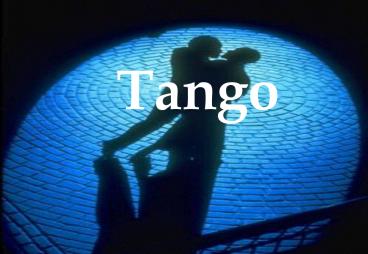Tango - PowerPoint PPT Presentation
1 / 14
Title:
Tango
Description:
... many different types of guitar, used both for chords and also for melodies and solo ... Try playing the 4 chords below and get to know the sound of them. ... – PowerPoint PPT presentation
Number of Views:627
Avg rating:3.0/5.0
Title: Tango
1
Tango
2
Where did the Tango come from?
Tango music originated at the beginning of the
19th century in Argentina. Buenos Aires (the
capital) was little more than a village at the
furthest corner of the Spanish Empire. The
British went over and built a huge railway across
Argentina. This opened up the deserted country
into one of great potential in exporting
agriculture and minerals. The only thing missing
now were workers, so the government shipped in
European men. Buenos Aires became full of male
workers but there were few woman around to start
creating families. One of the only ways for a
man to get close to a woman was to dance. The
tango was born in courtyards of the mens
housing.
The music and dance became a common language that
united people from many different cultures. It
was here that the different music and dance
styles brought by immigrants from different
countries, and by the people already in
Argentina, blended together, and what emerged
slowly became Tango.
3
Introduction to Tango
Listening 2- Duo de Amor
Listening 1- El Tango de Roxanne
Which instrument plays the introduction?
What instruments do you hear?
How many beats in the bar?
Does the tempo stay the same?
What do you hear in the bass line?
What instrument plays the bass line?
Listening 4 - Yoyo verde
Listening 3 Cell block Tango
Describe the rhythm in the opening section.
What role do the voices have?
What language is the voice in?
Is the bass line repetitive?
4
The dance
For a time the Tango was discouraged by the
Argentine government because it was associated
with crime, poverty and prostitution and
therefore gave a poor image of Argentinean
culture. Now it is a national obsession in
Argentina, with street performers dancing and
singing the Tango, and special theatres where
Tango shows take place daily. The dance features
quick jerky movements in response to the fast
moving notes of the dance. The two dancers are
usually very close with a very serious
expression. Eye contact with dance partner is
important in the Tango.
Watch the tango scene from the film Moulin Rouge.
(Disc 2, more, dance, tango!) Notice How the
dancers move in time to the music and their
short/sharp movements.
5
Instruments
Double Bass the lowest of the string family
Flute woodwind instrument that plays the
melodies
A free reed instrument particularly popular in
Argentina. The Bandoneón is played by holding
the instrument between both hands and either
pushing in or pulling out the instrument while
simultaneously pressing one or more buttons with
the fingers.
There are many different types of guitar, used
both for chords and also for melodies and solo
Violin the highest of the string instruments
6
Tango Rhythms
There are 2 common rhythms used in Tango music.
Try clapping the 2 rhythms below. These can be
used when composing your Tango pieces.
7
Your task is to compose your own Tango
Tangos are usually in a minor key to reflect the
seriousness of the dance and use 4 main chords
(I, IV, V VI)
Step 1
Try playing the 4 chords below and get to know
the sound of them. Remember to look at the
different clefs (bass and treble) and the
different letter names.
RH
LH
8
Step 2
In pairs try playing this simple 8 bar chord
sequence using only 2 chords.
Once you have done this try this 8 bar chord
sequence that uses 4 different chords.
9
Bass Line
Now you have learnt the chord sequence you need
to make it sound more like a Tango. To do this
we are going to change the bass line and make it
more exciting using the rhythms we learnt
previously.
The chord stays the same while the bass line
becomes more complicated
Try and work out what the bass line would be for
the other chords you have learnt.
10
Bass line continued
Now try playing the whole chord sequence with the
new bass line. One person can play the chord and
the other the bass line. (Remember the G) If
you look at the bass line the rhythm in every bar
is the same. Only the notes change, this is
called an ostinato.
11
Tango melodies
Tango melodies have chromatic notes. Chromatic
notes are a semitone apart. (Next door notes on
the piano usually moving from black to white
keys).
A E
If your melody goes from A to E you can add
chromatic notes to join them, similar to adding
passing notes in theme and variation.
A G A B C C D Eb E
12
Writing your melody
Now you can play the bass and chords your tango
needs a melody. This would usually be played on
a violin or flute. You can play yours on the
piano or keyboard.
Using the knowledge you have from writing your
melody for theme and variation write one note for
each bar to create a simple melody.
13
Melody writing
Now you have your simple melody line you can
begin to add your chromatic notes to make it
sound more like a tango. It is now up to you to
write your composition. Use the worksheets
provide to help you. To get a high level in your
assessment you should try and include the
following
Chromatic notes in your melody Structure your
piece should have at least 8 bar sections A and
then B (Binary form) Ostinato in the bass line.
14
(No Transcript)























![Download ⚡️[EBOOK]⚡️ The Meaning of Tango: The Story of the Argentinian Dance PowerPoint PPT Presentation](https://s3.amazonaws.com/images.powershow.com/10070419.th0.jpg?_=20240702026)







